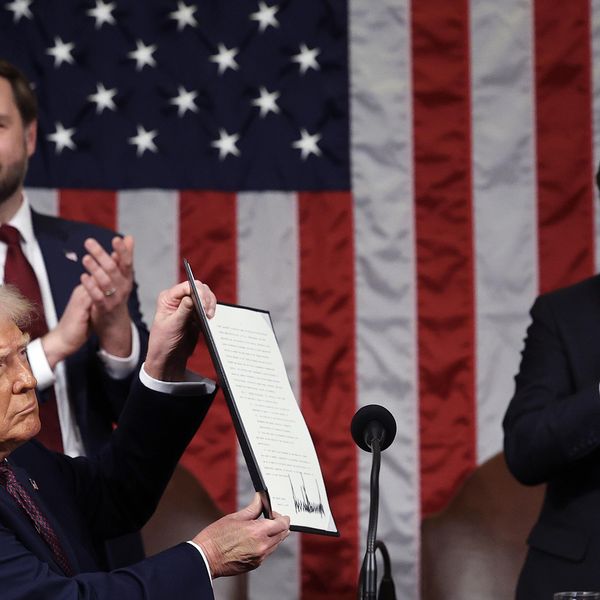A measure to cut the defense budget by 10 percent is on its way to defeat in Congress, but it’s an idea worthy of reviving and a useful reminder of what else the Pentagon’s excess billions could buy. While defense analysts generally insist that budgets must result from strategic reform, imposing a large and simple cut on the Pentagon can actually be a way to revive debate about its missions and generate support for a strategy of restraint. That means an approach to defense that reduces the militarism of U.S. foreign policy, ends wars, and does less to defend rich, capable allies.
The House yesterday defeated an amendment to the National Defense Authorization Act sponsored by Mark Pocan (D-Ill.) and Barbara Lee (D-Calif.) to cut $74 billion, or 10 percent from defense spending, except for personnel and healthcare. A companion Senate amendment sponsored by Bernie Sanders (I-Vt.) and Ed Markey (D-Mass.) would make the same cut and specifies that the savings are transferred to education, health care, and other domestic programs.
While the cut might seem huge, it would actually only take Pentagon spending to about the level it was before Donald Trump took office and layered a pile of new spending on the Pentagon without bothering to articulate strategic rationale. It’s also about the amount of money now annually spent on Overseas Contingency Operations, the war budget, half of which actually goes to regular Defense Department coffers.
There are several problems with this mode of making cuts. For one, by exempting personnel, it dodges charges that it targets “the troops” but prevents a reduction in manpower that would accompany sensible efforts to restrain Pentagon ambitions. Second, by shifting all the cuts to domestic programs without a dollar for deficit or tax reduction, it makes Republican support unlikely. Third, because it is just an amendment — as opposed a reduction of the congressional budget process — it is a one-time only cut and one made without the benefit of a change in strategic orientation.
The first two flaws could be corrected if the legislation is revived. The third is actually less a flaw than a concession to political reality. Ideally, yes, budget cuts would come as a reward for victory in a marketplace of strategic ideas, where you win out among wonks, congressional staff, and their bosses to adopt a more restrained strategy through the congressional committee process and then gather savings by shedding missions, force structure, and its associated operational costs.
But the ideal probably isn’t attainable, especially today in Washington. Strategy shifts with great difficulty because it reflects entrenched political interests. And U.S. safety today prevents rivals from shocking us into strategic reassessment, as the Soviet Union did at the start of the Cold War.
The United States is powerful and wealthy enough to confuse what it wants abroad with “security” and avoid strategy, which means prioritizing among threats and responses. U.S. strategy documents tend to list desires to protect Pentagon constituencies. In that sense they function more to prevent strategy than to create it. If cuts have to wait for strategic change they may never come, which is a reason defense hawks tend to insist on a proper process.
Yet there are good reasons for people to agree to cut the Pentagon without exactly agreeing on a new defense strategy. They may agree that the world’s most powerful country, one geographically remote from major rivals, can spend a lot less than $740 billion to stay safe. Or they could simply agree that coronavirus generated a pile of new spending and debt that suggests future spending cuts. The virus, and the economic trouble it created, is also a reminder that defense spending — now higher than at almost any point in the Cold War in terms of purchasing power — is way less important to the personal well-being of most Americans than many other potential uses of their tax dollars.
Cuts can be a means to generate strategic change, rather than its results. Relative austerity can spark reform, including the strategic sort. Less money forces Pentagon leaders to hunt for administrative bloat, heighten scrutiny of programs, and even identify excess missions. This is especially true if cuts fall unevenly, as they did under Eisenhower’s New Look strategy in the 1950s. The resulting bureaucratic fights spilled into Congress and the public and unearthed information that helped civilian policymakers make good choices.
The defense cuts of the 1990s and last decade, however, show how simply imposing cuts can go wrong. Each time, service chiefs allied to distribute the pain equally, blocking the shifts in resource allocation that real strategy demands. The recent cuts imposed by the 2011 Budget Control Act, initially seemed like they would cause some movement toward restraint. As Pentagon leaders complained they couldn’t execute the national security strategy without higher budgets, the Obama administration began a limited strategic pruning in 2012, saying it would reduce force structure in Europe and shrink ground forces in anticipation of avoiding large counterinsurgency campaigns.
But the Pentagon dodged the budget crunch as Congress repeatedly raised defense spending caps and used the uncapped war account to fund the base defense budget and further numb the pain. The reforming impetus dissipated, and strategic ambitions remained mostly unchanged, with slightly less funding.
Avoiding that outcome next time requires Pentagon leaders who manage cuts. Civilian leaders should intervene to prevent equal distribution of pain by picking some winners as the budget descends. Beneficiaries of change can help advocate it. Likewise, the movement of defense largesse to interests outside the Pentagon, even tax cuts or deficit reduction, creates incentives for recipients to promote cuts and justify them with restraint.
Managed right, Pentagon budget cuts can build support for a strategy of restraint. Demands for a perfect process shouldn’t prevent efforts to impose lower defense spending.
















